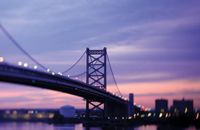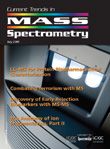57th ASMS Conference Review
Special Issues
The 57th ASMS Conference on Mass Spectrometry was held at the Pennsylvania Convention Center, 1101 Arch Street, Philadelphia, Pennsylvania, from May 31 through June 4, 2009.
The 57th ASMS Conference on Mass Spectrometry was held at the Pennsylvania Convention Center, 1101 Arch Street, Philadelphia, Pennsylvania, from May 31 through June 4, 2009.

( PHOTO: GETTY IMAGES)
The conference began early for some attendees, with several one-and two-day short courses beginning on Saturday, May 30 from 9 a.m. to 4:30 p.m. Sunday followed with more short courses and informative tutorial lectures from 5:00 to 6:30 p.m.
Williard H. Harrison gave a tutorial lecture titled, "The Art of Communication in the Sciences." Harrison is Dean Emeritus and a professor in the Department of Chemistry at the University of Florida, Gainseville. He received the Ph.D. degree from the University of Illinois, where his research interests in analytical, optical, and mass spectroscopy took flight. Professor Harrison is a member of the honor society of Phi Kappa Phi, has published 109 research papers, delivered 92 lectures, and presented 138 contributed papers, a number of which were on the topic of glow discharges. Needless to say, Harrison had a wealth of knowledge to offer on the topic of communication in the sciences.
David E. Clemmer, a professor for the chemistry department at Indiana University, gave another tutorial lecture titled, "Ion Mobility in Mass Spectrometry." Professor Clemmer received the Ph.D. in chemistry from the University of Utah and did postdoctoral work at the Himeji Institute of Technology (Japan) and Northwestern University. Professor Clemmer has published more than 135 papers and his work has been recognized with several awards, including the Fresenius Chemistry Award. He has also been a member of the U.S. Defense Science Study group.
Following the tutorial lectures was the official opening session and Plenary Lecture, which featured a talk from Jerald L. Schnoor, of the University of Iowa, entitled, "Biofuels and Global Climate Change." This topic was especially fitting for the June conference as gas prices and temperatures are on the rise once again this summer. Schnoor received the B.S. degree in chemical engineering from Iowa State, the M.S. degree in environmental health engineering, from the University of Texas, and the Ph.D. degree in civil engineering from the University of Texas. Throughout his career, Schnoor has been very active in environmental issues. He testified several times before Congress on the environmental effects of acid deposition and the importance of passing the 1990 Clean Air Act. As Editor-in-Chief of Environmental Science and Technology, Schnoor guided the leading journal in the world in both environmental engineering and environmental science. Professor Schnoor has published (as author, co-author, or editor) six books and over 150 research articles in archival journals, in addition to serving as lead editor of a series of texts and monographs for John Wiley & Sons. His vast array of knowledge and his passion for environmental issues was evident in his lecture. Professor Schnoor was an eloquent speaker and surely set the bar high for the rest of the week with his thought-provoking presentations.
Monday through Thursday were full program days consisting of oral sessions, poster sessions, and workshops. A few popular oral sessions from the week were, "Chromatography–Mass Spectrometry Approaches to Increase Throughput in Discovery PK Assays;" "Mass Spectrometry in Environmental Toxicology;" "Mass Spectrometry in Homeland Protection;" and "Novel LC–MS Techniques for Regulated Bioanalysis of Drugs." These are just a few of the great topics that this year's ASMS covered. All of the sessions were well researched and offered a lot of practical knowledge to any chromatography or mass spectrometry user.
Awards
Several awards were given at ASMS this year, and they are among the most prestigious in the field. The Award for Distinguished Contribution in Mass Spectrometry is handed out each year and "recognizes a focused, singular achievement in or contribution to fundamental or applied mass spectrometry." Past winners have included some of the most well known names in mass spectrometry, including last year's awardee, Alexander Makarov of ThermoFisher Scientific. This year, two individuals shared the award, Simon J. Gaskell of the University of Manchester, U.K., and Vicki Wysocki of the University of Arizona. The co-winners were honored for their parallel work in the creation of the "Mobile Proton Model," which unified diverse observations of real-world collision-induced peptide sequencing and protein interference. Their pioneering work began in 1992, and this model has formed the basis upon which the work of countless other researchers has been based.
The Biemann Medal "recognizes a significant achievement in basic or applied mass spectrometry made by an individual early in his or her career." The winner also must be within 15 years of receipt of his or her Ph.D. degree at the time of nomination. This year's winner was Neil L. Kelleher of the University of Illinois, Urbana-Champaign, for his groundbreaking work in the area of "Top-down Proteomics," which he helped popularize into the household term it has become today. Under Dr. Kelleher's leadership, his lab has become a driving force in the field, generating over 130 peer-reviewed papers and winning several major awards.
Finally, the Ron Hites Award is named in honor of Ronald A. Hites, who led the creation of the Journal of ASMS in 1988 while serving as president of the society, and honors a high-quality presentation of outstanding original research in the journal. This year's award went to Alison E. Ashcroft of Leeds University, U.K., for her paper titled "Monitoring Copopulated Conformational States During Protein Folding Events Using ESI-IMS-MS."
As always, a staple at ASMS was the hospitality suites, which featured complimentary cocktails, food, and a great atmosphere to meet and greet colleagues. Philadelphia was a wonderful setting for this conference, which definitely showed its "brotherly love" to all the ASMS conferees. Next year's ASMS conference is scheduled to be in Salt Lake City, Utah — we here at Spectroscopy can't wait to see what next year's program has to offer!

High-Speed Laser MS for Precise, Prep-Free Environmental Particle Tracking
April 21st 2025Scientists at Oak Ridge National Laboratory have demonstrated that a fast, laser-based mass spectrometry method—LA-ICP-TOF-MS—can accurately detect and identify airborne environmental particles, including toxic metal particles like ruthenium, without the need for complex sample preparation. The work offers a breakthrough in rapid, high-resolution analysis of environmental pollutants.
The Fundamental Role of Advanced Hyphenated Techniques in Lithium-Ion Battery Research
December 4th 2024Spectroscopy spoke with Uwe Karst, a full professor at the University of Münster in the Institute of Inorganic and Analytical Chemistry, to discuss his research on hyphenated analytical techniques in battery research.
Mass Spectrometry for Forensic Analysis: An Interview with Glen Jackson
November 27th 2024As part of “The Future of Forensic Analysis” content series, Spectroscopy sat down with Glen P. Jackson of West Virginia University to talk about the historical development of mass spectrometry in forensic analysis.
Detecting Cancer Biomarkers in Canines: An Interview with Landulfo Silveira Jr.
November 5th 2024Spectroscopy sat down with Landulfo Silveira Jr. of Universidade Anhembi Morumbi-UAM and Center for Innovation, Technology and Education-CITÉ (São Paulo, Brazil) to talk about his team’s latest research using Raman spectroscopy to detect biomarkers of cancer in canine sera.